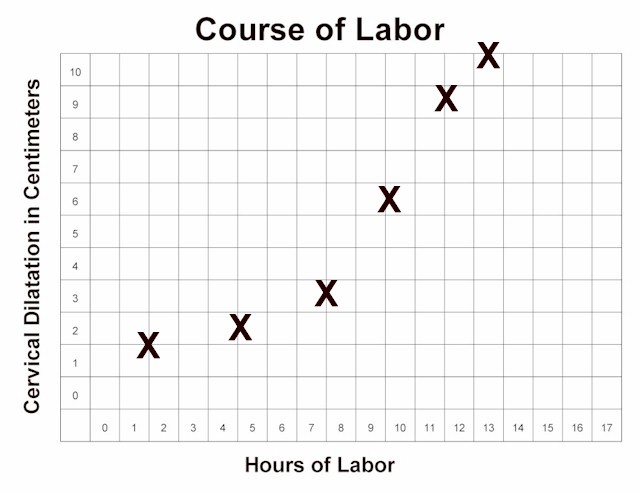Normal labor progresses slowly
during the latent phase. Then, after 4 cm dilatation, the more rapid,
active phase of labor begins.
During active labor (at least 6 cm), the
cervix should progressively dilate at a rate of no less than 1.2 cm/hour (for first babies) to 1.5
cm/hour (for subsequent babies). If active labor progresses more slowly than this, an
"arrest of labor" has occurred.
The arrest of labor may be simple slowing of the labor below the expected rate, or may
represent a complete arrest, in which there is no further progress beyond 6 cm for at least 4 hours, in the presence of adequaate contractions. 6 hours or more of inadequate contractions with no cervical change is also considered an arrest of labor.
There are essentially only two causes for an arrest of labor in the
active phase:
 Contractions may be inadequate because they are too infrequent (more than 4 minute
intervals), or do not last long enough (less than 30 seconds). Typically,
they are neither frequent enough nor long enough. Contractions may be inadequate because they are too infrequent (more than 4 minute
intervals), or do not last long enough (less than 30 seconds). Typically,
they are neither frequent enough nor long enough.
Mechanical impediments to labor may include:
-
Absolute feto-pelvic disproportion, in which the maternal pelvis is not large enough to
allow the baby to pass through the birth canal.
-
Relative feto-pelvic disproportion, in which there is a snug fit, but given time and
adequate contractions, the baby can safely negotiate the birth canal
-
Fetal malposition, in which the fetal head is presenting in a less favorable position
(for example, occiput posterior, or with fetal hand preceding the head, or a transverse
lie)
-
Asynclitism, in which the fetal head is angled slightly to one side, making it more
difficult for a clear passage through the birth canal.
Inadequate contractions are treated with uterine stimulation. This is generally
accomplished with intravenous oxytocin, delivered in steady, small amounts with a
controlled infusion pump. The dose is started relatively low, and then advanced gradually
until the desired effect is achieved. Later in labor, the dosage is often adjusted
downward or stopped altogether if the contractions are too close together (consistently
more than 5 contractions every 10 minutes).
Amniotomy (artificial rupture of the bag of waters) can also be a
effective stimulus to labor. Amniotomy may be safely performed if the fetal
head is sufficiently engaged in the maternal pelvis to keep the umbilical cord
from slipping past it, creating a prolapsed cord situation.
Nipple stimulation (rolling the nipple back and forth with thumb and forefinger) will
cause of release of the mother's own oxytocin from her pituitary gland. This will have the
effect of stimulating contractions. Stimulating both nipples will have about double the
effect as stimulating one nipple. After about 15-20 minutes of nipple stimulation you will
have released about as much natural oxytocin as is available. Nipple stimulation can be
repeated at a later time, after the natural oxytocin supply has been replenished.
-
While this technique can be effective, the biggest problem is overstimulation of the
uterus because of too much oxytocin. Rather than achieving more
frequent, longer contractions, you will end up with a single, 3-5 minute
contraction that is threatening to the fetus and the integrity of the
uterus.
-
Start with stimulation of just one nipple. Have the mother perform this on herself. It
usually takes 3-5 minutes of this before you will notice any effect on the uterus. If
gentle nipple stimulation is not effective, increase the strength of the nipple massage.
If there is still no result, you can try stimulating both nipples. Just make sure to give
the uterus enough time to respond.
The possibility of a mechanical impediment should be considered whenever arrest
disorders occur.
-
If the fetus is in a transverse lie, it will not be able to deliver vaginally and
continuing labor will ultimately lead to uterine rupture.
-
If the fetus is in an occiput posterior position, vaginal delivery may still be
successful, but it will take longer.
-
If the fetus is a little large for the birth canal, vaginal delivery may still be
successful, but only with time and fetal molding to the shape of the pelvis.
-
If there is a compound presentation (head and hand, for example), the baby may still
come through, but it may take much longer. (Try pinching the hand to see if the fetus will
react by pulling it up and out of the way.)
Usually, there is no way to know in advance which labors will experience an absolute
obstruction and those that will not. For this reason, a trial of labor is almost always
indicated. Those patients with an absolute obstruction will demonstrate a complete arrest
pattern and will need cesarean section. |

Normal Labor

Arrest of Active Labor
|